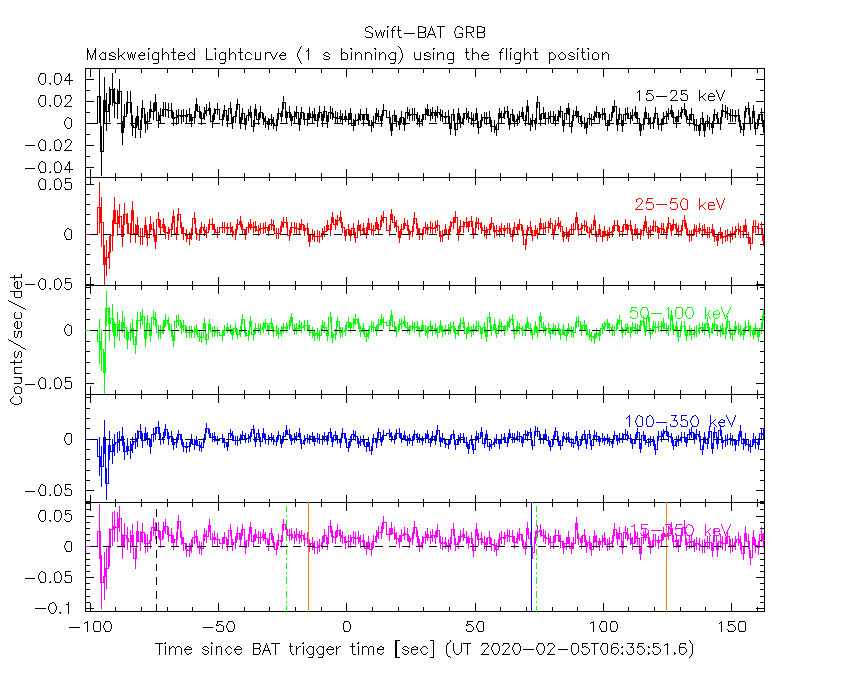
P.A. Evans (U. Leicester) and J.P. Osborne (U. Leicester) for the Swift team
At 06:35:51 UT, the Swift Burst Alert Telescope (BAT) triggered and located GRB 200205A (trigger=954304) (Evans et al. GCN Circ. 26982). Swift slewed immediately to the burst. At the time of the trigger, the initial BAT position was 128° from the Sun (11.5 hours East) and 73° from the 80%-illuminated Moon. Table 1 contains the best reported positions from Swift.
Lipunov et al. (GCN Circ. 26984) reported the position from MASTER for the optical afterglow of this GRB. Table 2 is a summary of GCN Circulars about this GRB from observatories other than Swift.
Standard analysis products for this burst are available at https://gcn.gsfc.nasa.gov/swift_gnd_ana.html.
As reported by Stamatikos et al. (GCN Circ. 27010),
the BAT ground-calculated position is RA, Dec = 130.168, -35.275 deg which is RA(J2000) = 0
The mask weighted light curve (Figure 1) shows some weak emission which started before the source came into BAT field of view (which is ~ T-100 s). Kennea et al. 2020 (Atel #13452) discuss the properties of this newly discovered X-ray transient. The lower limit of the duration of the burst as detected by BAT is ~ 200 s. The source went out of BAT field of view at ~T+260 s, with a possibility of continuing emission which may be detected by other telecopes.
The time-averaged spectrum from -81.88 to 132.86 s is best fit by a power law with an exponential cutoff.
This fit gives a photon index 0.84 ± 0.91, and
The results of the batgrbproduct analysis are available at https://gcn.gsfc.nasa.gov/notices_s/954304/BA/.
We have analysed 14 ks of XRT data for GRB 200205A, from 127 s to 219.2 ks after the BAT trigger. The data comprise 863 s in Windowed Timing (WT) mode (the first 8 s were taken while Swift was slewing) with the remainder in Photon Counting (PC) mode. The enhanced XRT position for this burst was given by Osborne et al. (GCN Circ. 26996).
The light curve (Figure 2) can be modelled with a series of power-law decays. The initial decay index is α=2.29 ± 0.18. At T+666 s the decay flattens to an α of -1.50 (+0.00, -0.20). The light curve breaks again at T+5675 s to a decay with α=8.00 (+0.00, -0.13), again at T+6208 s s to α=3.12 ± 0.08, and again at T+38.0 ks s to α=-0.8 (+0.4, -0.6), before a final break at T+159 ks s after which the decay index is 3.0 (+1.8, -0.5).
A spectrum formed from the WT mode data can be fitted with an absorbed power-law with a photon spectral index of 1.06 (+0.06, -0.04). The best-fitting absorption column is consistent with the Galactic value of 4.3 x 1
A summary of the PC-mode spectrum is thus:
Total column: 6.8 (+1.5, -1.3) x 1
Galactic foreground: 4.3 x 1
Excess significance: 3.2 σ
Photon index: 2.12 (+0.21, -0.20)
The results of the XRT team automatic analysis are available at http://www.swift.ac.uk/xrt_products/00954304.
UVOT results are not available.

Figure 1. The BAT
mask-weighted light curve in the four individual and total
energy bands. The units are counts

Figure 2. The XRT light curve.
Any data from a crosshatched region are not included in the fit.
| RA (J2000) | Dec (J2000) | Error | Note | Reference |
|---|---|---|---|---|
| 0 |
-35°16'24.6" | 0.8" | UVOT | ? |
| 0 |
-35°16'24.8" | 1.9" | XRT-final | UKSSDC |
| 0 |
-35°16'25.2" | 1.9" | XRT-enhanced | Osborne et al. GCN Circ. 26996 |
| 0 |
-35°16'30.9" | 3.0' | BAT-refined | Stamatikos et al. GCN Circ. 27010 |
| Band | Authors | GCN Circ. | Subject | Observatory | Notes |
|---|---|---|---|---|---|
| Optical | Lipunov et al. | 26983 | Swift GRB 200205A: Global MASTER-Net observations report |
MASTER | |
| Optical | Lipunov et al. | 26984 | MASTER Ot detection | MASTER | detection |
| Optical | Lipunov et al. | 26985 | MAXI GRB200205.29: Global MASTER-Net observations report |
MASTER | |
| Optical | Melandri et al. | 26986 | REM optical observations | REM | detection |
| Optical | Malesani et al. | 26989 | Swift trigger 954304: VLT optical observations |
VLT | |
| Optical | Buckley et al. | 26991 | Swift GRB200205.81: Global MASTER-Net OT detection |
MASTER | detection |
| Optical | Lipunov et al. | 26992 | Swift GRB200205.81: Global MASTER-Net observations report |
MASTER | |
| Optical | Mazaeva et al. | 27003 | = Swift J0840.7-3516: optical photometry in Chilescope observatory |
detection | |
| X-ray | Niwano et al. | 26987 | MAXI/GSC detection | MAXI | detection |
February 8, 2020